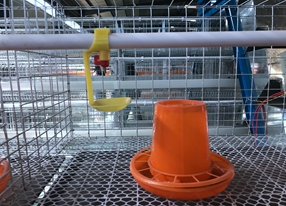feed pellet cooler
Dec . 12, 2024 06:00 Back to list
feed pellet cooler
Understanding Feed Pellet Coolers Essential Components for Optimal Animal Nutrition
In the realm of animal farming, particularly in livestock and poultry production, the quality of feed is paramount. One key factor that significantly impacts the quality of feed pellets is the cooling process, which is facilitated by feed pellet coolers. This article aims to delve into the importance, functioning, and considerations surrounding feed pellet coolers, providing insights for farmers and feed manufacturers alike.
Importance of Feed Pellet Cooling
Feed pellets are produced by compressing raw materials, such as grains and additives, through a pellet mill. During this process, the pellets are subjected to high temperatures and moisture content. While this heat helps in sanitizing the feed and improving digestibility, it also poses risks if not properly managed.
Cooling the pellets post-production is critical for several reasons
1. Moisture Reduction Freshly produced pellets can contain significant moisture, which may lead to spoilage and mold growth. Effective cooling reduces moisture content, prolonging the shelf life of the feed.
2. Hardness and Durability Cooling enhances the hardness of pellets, making them more durable during transportation and storage. This durability is vital for ensuring that the feed remains intact until consumption.
3. Nutrient Retention Proper cooling helps in retaining essential nutrients in the feed. Excessive heat can degrade vitamins and minerals, thus diminishing the nutritional value of the feed offered to livestock.
4. Feed Flowability Well-cooled pellets have improved flowability, making them easier to handle, distribute, and feed to animals. This efficiency is crucial in large-scale operations.
How Feed Pellet Coolers Work
Feed pellet coolers are designed to lower the temperature and moisture content of freshly produced pellets. The most common types of coolers include counterflow coolers and rotary coolers.
feed pellet cooler

- Counterflow Coolers This type of cooler operates by passing cool air in the opposite direction to the flow of hot pellets. As the pellets move down through the cooler, they lose heat to the incoming cool air, which absorbs moisture. This method is highly efficient and ensures uniform cooling.
- Rotary Coolers In rotary coolers, pellets are distributed in a rotating drum where cool air circulates. This design is effective in promoting even cooling and reducing moisture content, although it may require more energy compared to counterflow coolers.
The choice of cooler depends on various factors, including production volume, budget, and space availability.
Considerations for Selecting a Feed Pellet Cooler
When selecting a feed pellet cooler, several considerations should be factored in
1. Production Capacity Assessing the cooling capacity in relation to the feed production output is critical. The cooler should be able to handle peak production without bottlenecks.
2. Energy Efficiency Energy costs can significantly impact overall production costs. Choosing a cooler that operates efficiently can lead to substantial savings over time.
3. Maintenance Regular maintenance is crucial for ensuring the longevity of the cooler. Opt for models that are easy to clean and maintain.
4. Cost While investing in a high-quality cooler may seem costly, the long-term benefits derived from improved feed quality and reduced waste often outweigh initial expenses.
Conclusion
In conclusion, feed pellet coolers play a vital role in the animal nutrition industry by ensuring the quality, safety, and longevity of feed. Farmers and feed manufacturers must prioritize the selection of an appropriate cooler to meet their specific needs and enhance their operational efficiency. Through effective cooling processes, they can provide high-quality nutrition to livestock, ultimately leading to better production outcomes and healthier animals. As the industry continues to evolve, the importance of such systems remains undeniable in achieving sustainable and profitable farming practices.
-
Hot Sale 24 & 18 Door Rabbit Cages - Premium Breeding Solutions
NewsJul.25,2025
-
Automatic Feeding Line System Pan Feeder Nipple Drinker - Anping County Yize Metal Products Co., Ltd.
NewsJul.21,2025
-
Automatic Feeding Line System Pan Feeder Nipple Drinker - Anping County Yize Metal Products Co., Ltd.
NewsJul.21,2025
-
Automatic Feeding Line System - Anping Yize | Precision & Nipple
NewsJul.21,2025
-
Automatic Feeding Line System - Anping Yize | Precision & Nipple
NewsJul.21,2025
-
Automatic Feeding Line System-Anping County Yize Metal Products Co., Ltd.|Efficient Feed Distribution&Customized Animal Farming Solutions
NewsJul.21,2025






